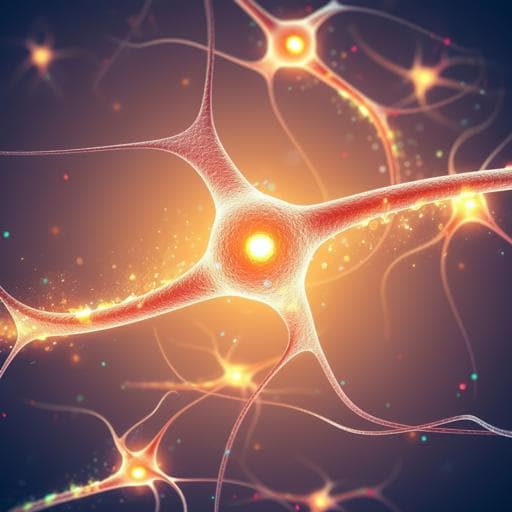
Psychology
Association of polygenic risk scores and hair cortisol with mental health trajectories during COVID lockdown
K. F. Ahrens, R. J. Neumann, et al.
Discover how genetic factors and stress hormone levels influenced mental health during the COVID-19 pandemic. This groundbreaking research by Kira F. Ahrens and colleagues reveals distinct mental health trajectories, shedding light on risk prediction for future crises.
~3 min • Beginner • English
Introduction
The study examines whether genetic predisposition, quantified via polygenic risk scores (PRSs) for psychiatric phenotypes, and long-term cortisol secretion, indexed by hair cortisol concentration (HCC), are associated with distinct mental health trajectories during the first COVID-19 lockdown in Germany. Stress-related disorders are influenced by both genetic and environmental factors. HCC reflects long-term hypothalamus-pituitary-adrenal (HPA) axis activity and may indicate environmental stress/stressability, but prior findings linking HCC to stress-related disorders are mixed and often not truly prospective. PRSs capture additive genetic liability across many loci and pleiotropy is substantial across psychiatric disorders; thus, a bifactor model was used to derive a general genetic factor alongside domain-specific factors. Building on prior LORA work that identified three trajectories (resilient, acute dysfunction, delayed dysfunction), the authors hypothesized: (1) higher pre-pandemic HCC associates with acute and delayed dysfunction trajectories; (2) higher general genetic risk (general p factor) associates with deteriorating mental health under lockdown; (3, exploratory) disorder-specific PRSs relate to trajectories; and (4, exploratory) HCC x PRS interactions contribute to vulnerability.
Literature Review
The authors summarize evidence that adverse experiences and stress can precipitate stress-related disorders, yet individuals show heterogeneous post-adversity trajectories. HPA axis activity measured by HCC has been associated with objective stress exposures (e.g., shift work, chronic pain, hospitalization) but meta-analyses report inconsistent associations with stress-related disorders, and most purportedly prospective studies collected hair immediately post-event, confounding pre- and peri-trauma cortisol. On genetic risk, GWAS indicate highly polygenic architectures and pleiotropy across psychiatric disorders. Prior work has used multiple PRSs to predict mental health trajectories and factor analyses suggest higher-order structures (e.g., p factor) spanning disorders. Few studies have integrated PRSs with HCC; one reported a non-significant moderation of schizophrenia PRS by HCC on brain structure, and another found no association between HCC and PRSs for MDD or neuroticism. These gaps motivate an integrated analysis of HCC and PRS-derived general and domain-specific factors for predicting mental health trajectories.
Methodology
Design and sample: Extension of the Longitudinal Resilience Assessment (LORA) study (ongoing since 2017). With the onset of COVID-19, 523 of 1191 LORA participants completed weekly online surveys over the first 8 weeks of Germany's "soft" lockdown; mental health was measured by GHQ-28. Latent growth mixture modeling previously identified three classes: resilient (82.6%), acute dysfunction (9.0%), delayed dysfunction (8.4). For the present analyses, pre-pandemic biosamples were used: hair cortisol data (n=192), genetic data for PRS (n=364), with overlap n=142. Ethics approvals and written consent obtained.
PRS calculation: DNA from blood collected at LORA baseline. Genotyping in 959 participants on Illumina GSA-MD v1.0; QC with PLINK v1.9 excluded participants based on heterozygosity >0.2, missingness >0.02, sex mismatch, relatedness (pi-HAT >0.2), and SNP-level filters (MAF ≤0.01, non-unique/tri-allelic, call rate ≤0.98, HWE deviations). PCA excluded population outliers (SD6 in first 20 PCs). Final LORA post-QC n=897; of these, 364 had both PRS and COVID trajectory data. PRSs computed using PRSice-2 v2.3.1e with clumping (250 kb, r2=0.1), and base GWAS for 12 phenotypes with pT chosen for maximal variance explained: ADHD (pT=0.1), BPD (0.01), ALC (0.01), ANO (0.05), ANX (0.1), AUT (0.5), MDD (0.3), OCD (0.1), OPI (1.0), PTSD (0.2), SCZ (0.05), NEU (0.1). Base files filtered by MAF>0.01 and INFO>0.8; no sample overlap. Covariates: age, sex, first five PCs. PRSs were z-transformed. Dimensionality reduction via exploratory bifactor analysis with Schmid-Leiman transformation to derive one general factor (general pleiotropic pPRS) and four sub-factors.
Hair cortisol (HCC): Hair sampled quarterly at LORA baseline and follow-ups, providing three 3-cm segments per participant (each reflecting prior 3 months), spanning a 9-month period, with last sample 5–27 months prior to lockdown. Assay conducted by Dresden Lab Service per Davenport et al. protocol: washing in isopropanol, methanol extraction (18 h), evaporation, reconstitution, and CLIA (IBL-Hamburg). Intra-/inter-assay CV <8%. Extreme outliers removed (IQR-based), values log- and z-transformed. Reliability across three measures: ICC=0.76 (95% CI 0.69–0.82), p<0.001. Averaged across three timepoints to index trait-like HCC.
Statistical analysis: Bivariate logistic regressions tested associations between (a) HCC and class membership (acute vs resilient; delayed vs resilient) in n=192, controlling for age, sex, pre-lockdown GHQ, and the time interval between hair sampling and lockdown; sensitivity analyses further adjusted for hormonal contraception and hair treatment. (b) PRS-derived factors (general pPRS, INT, PSY, ND, DYS) and class membership in n=364, controlling for age, sex, and pre-lockdown GHQ. Exploratory interaction models tested HCC x PRS factor interactions (subset with both measures) for predicting class membership. Model fit indices reported for bifactor model (e.g., χ², BIC, RMSR, RMSEA).
Key Findings
- Bifactor model of 12 PRSs supported 1 general factor and 4 sub-factors with good fit: χ²(24)=20.36, p=0.68; BIC=−121.17; RMSR=0.02; RMSEA<0.01; Omega total=0.61; Alpha=0.51. Sub-factors: INT (MDD, ANX, NEU), PSY (SCZ, BPD, ANO), ND (ADHD, AUT), DYS (PTSD, ALC, OPI, with negative loading of OCD). The general factor loaded ≥0.2 on MDD, ANX, NEU, SCZ, AUT, ADHD, PTSD.
- Hair cortisol (HCC): Higher pre-pandemic HCC predicted acute dysfunction vs resilient class: b=0.45, 95% CI [0.02, 0.91], p=0.045; OR=1.56; Nagelkerke R²=0.25. Association remained after adjusting for hormonal contraception, hair treatment, time interval, and pre-lockdown GHQ. No significant association for delayed dysfunction vs resilient (b=0.34, p=0.161; OR=1.41).
- Genetic risk (PRS factors): Higher general pleiotropic pPRS associated with acute vs resilient: b=0.44, 95% CI [0.06, 0.82], p=0.025; OR=1.55; R²=0.21. No significant association for delayed vs resilient (b=0.11, p=0.549). The ND factor (ADHD+AUT) also associated with acute vs resilient: b=0.43, 95% CI [0.04, 0.82], p=0.031; OR=1.53; R²=0.21; not significant for delayed vs resilient. INT, PSY, and DYS factors were not significantly associated with class membership. DYS showed a non-significant trend for acute vs resilient (b=0.30, p=0.099; OR=1.35).
- Interactions: No significant HCC x general pPRS (b=−0.17, p=0.593) or HCC x ND (b=0.05, p=0.846) interactions for predicting acute vs resilient. Main effect of HCC remained significant in combined models.
- HCC reliability: ICC=0.76 (CI [0.69, 0.82]), indicating moderate-to-good stability across three pre-pandemic assessments.
- Pre-lockdown GHQ differed across classes (e.g., PRS dataset: F(2)=8.78, p<0.001), with worse pre-pandemic mental health in vulnerable groups, consistent with prior work.
Discussion
Findings indicate that both elevated pre-pandemic hair cortisol (indexing long-term HPA activity) and higher general genetic liability across psychiatric disorders (general pPRS), as well as an exploratory neurodevelopmental (ND) PRS factor, are associated with an acute deterioration of mental health during the initial COVID-19 lockdown, relative to resilient trajectories. These results address the hypotheses by showing biological risk signals for the acute dysfunction trajectory but not for the delayed dysfunction trajectory. The lack of significant interactions between HCC and PRS factors suggests additive rather than multiplicative effects of physiological stress markers and polygenic liability in identifying individuals with heightened immediate stress reactivity. The bifactor approach supports a pleiotropic genetic liability structure and suggests that aggregated PRS information may be informative for trans-diagnostic vulnerability. HCC findings align with literature linking elevated hair cortisol to objectively stressful environments and support the notion that higher basal HPA activity (due to genetic predisposition and/or prolonged environmental stress) may lower thresholds for acute stress responses. However, the absence of effects for the delayed dysfunction group could reflect true specificity or be due to limited power; replication in larger samples is needed. Overall, integrating PRS-derived general liability and trait-like HCC may aid early identification of individuals prone to acute stress overreaction, potentially informing targeted preventive interventions.
Conclusion
This study provides empirical evidence that pre-pandemic long-term hair cortisol levels and a general pleiotropic polygenic risk factor are associated with acute mental health deterioration during the COVID-19 lockdown, while not identifying the delayed dysfunction group. A bifactor model effectively summarized shared and domain-specific genetic risks across 12 psychiatric phenotypes. These biological measures may help identify individuals with strong acute stress reactivity who could benefit from early preventive support. Future research should replicate these findings in larger, more diverse cohorts, refine PRS aggregation strategies, evaluate PRSs for long-term cortisol phenotypes when available, investigate mechanistic pathways linking HPA activity and genetic liability to stress responses, and track long-term outcomes of the acute and delayed dysfunction trajectories.
Limitations
- Limited sample sizes, especially within at-risk classes (e.g., HCC dataset: delayed n=28, acute n=32; complete dataset overlap smaller), reducing power, particularly for interaction tests.
- Exploratory bifactor model anomalies: correlations between the general factor and sub-factors; some PRSs with loadings <0.2 on the general factor; these are known issues in bifactor applications but question the general factor’s orthogonality; replication required.
- Overrepresentation of women, particularly in risk groups; although HCC effects remained significant after sex adjustment, generalizability may be affected.
- Base GWAS predominantly of European ancestry; factor structure and PRS performance may not generalize to other ancestries.
- Main effects were modest and may be unstable; the ND factor association did not survive multiple testing correction.
- Mechanistic inferences cannot be drawn; pathways linking genetic liability and HPA activity to acute stress responses remain to be elucidated.
Related Publications
Explore these studies to deepen your understanding of the subject.







